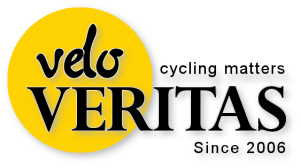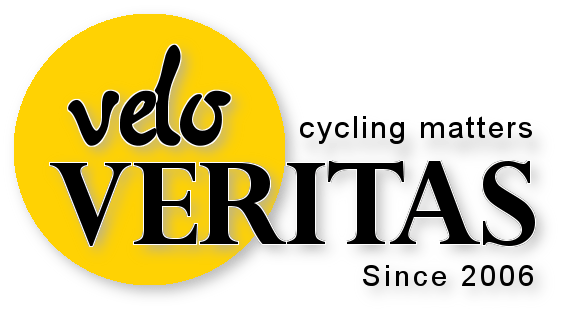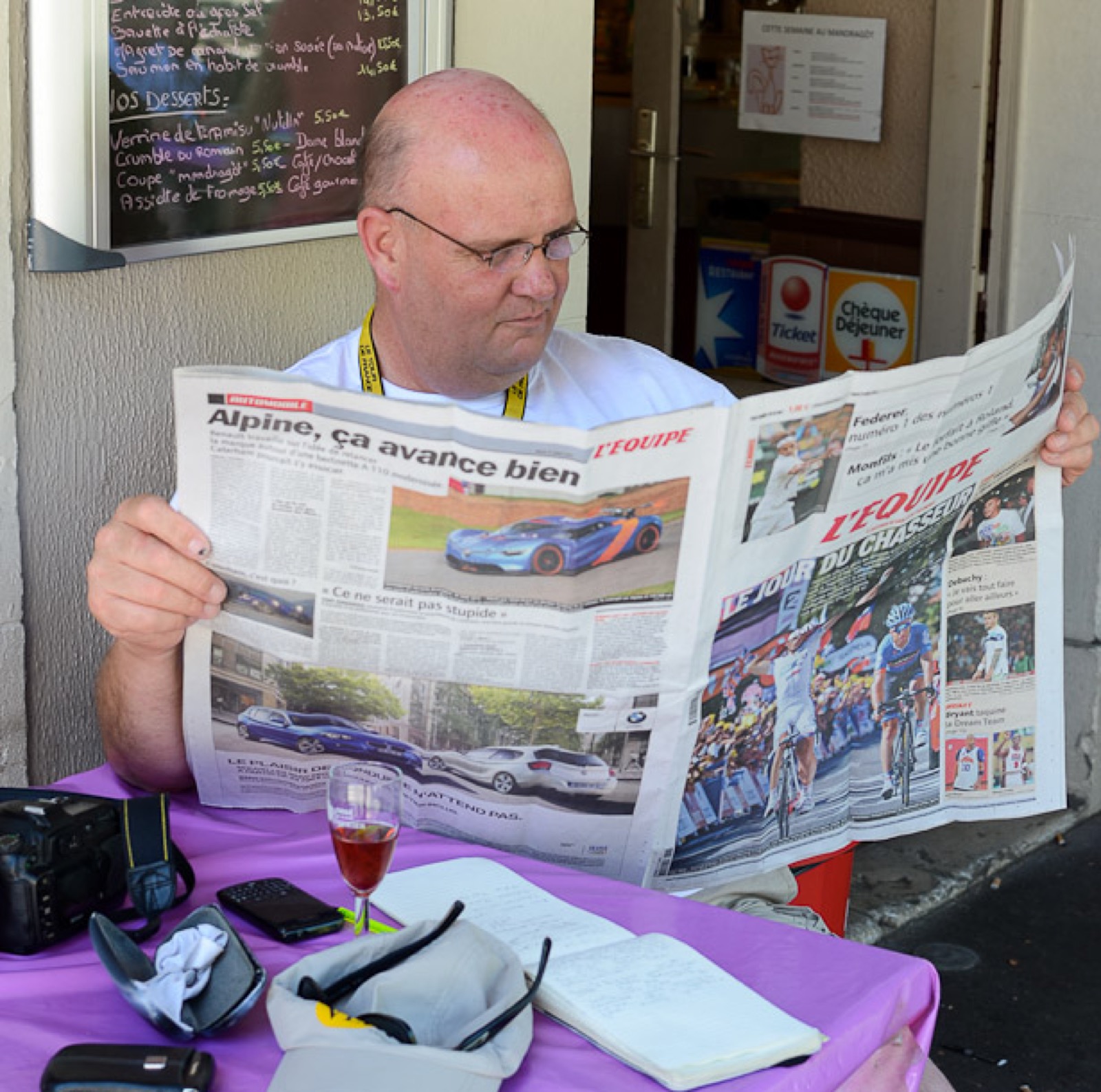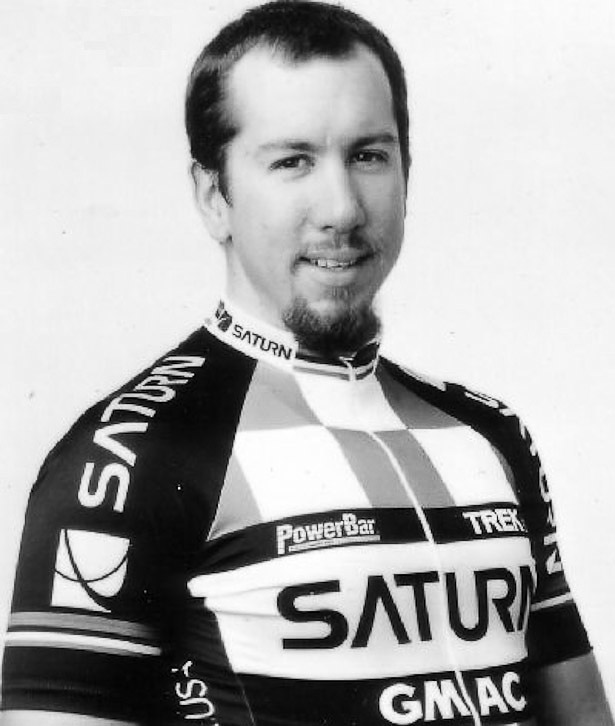
Continuing our series of pre-Track Worlds interviews with riders who came from the ‘left field’ of the velodrome, in this second part we talk to Mike McCarthy, a man who didn’t quite come from nowhere to win the 1992 World Professional Pursuit Championship but certainly shocked the world of the Euro Pros to take what was arguably then, the most prestigious of all the track titles.
The accepted wisdom is that McCarthy’s career started as a youngster riding, training and racing around New York’s Central Park.
But according to the man himself, his interest in cycling started much earlier;
“Before I even rode in Central Park my mom used to take me to the Kissena Park Velodrome in Queens.
“I raced at Kissena when I was 10 in the “stock bike” kids category. Basically anything with wheels was ok.
“It was in the middle of a rough area where stolen cars used to end up, burnt out.
“We went for three weeks in a row but then my mom’s work hours changed and she couldn’t take me any longer — it was another three years before I started to ride at Central Park.”
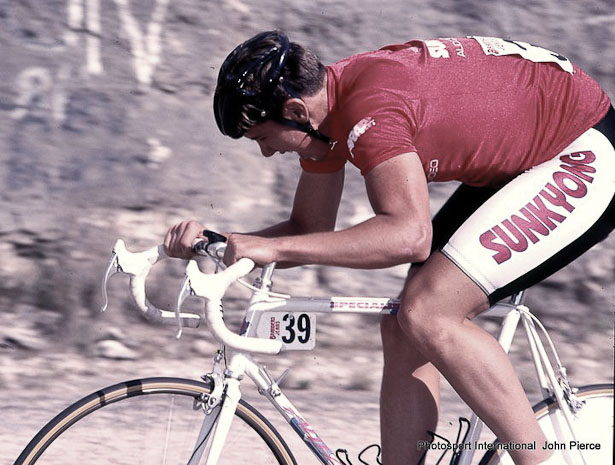
“It was a good team, the Dutch guy who started it – George Taylor – worked with Peter Post and Jim Ochowicz with whom he set up team 7-eleven.
“In 1989 it became Celestial Seasonings and was then disbanded.
“His wife was Korean and with the Olympics being in Korea that year he approached Sunkyong — it’s a huge corporation which no one has heard of but makes all sorts of things which other companies put their names on — and suggested they sponsor a team.
“The team went on to be Subaru-Montgomery then Montgomery-Bell then Postal.”
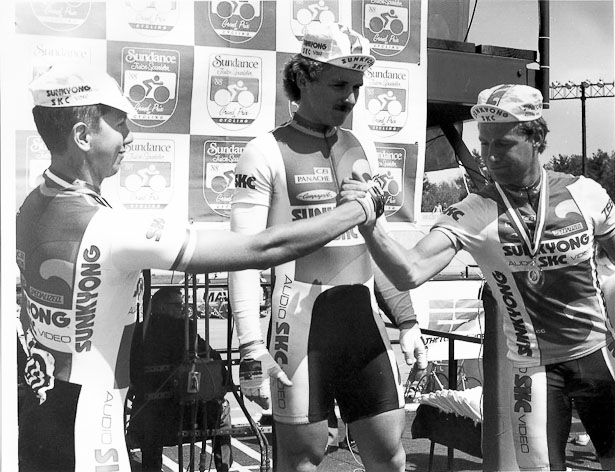
Whilst McCarthy enjoyed success at national and Pan American level, his first major ‘world stage’ result came in 1989.
But it wasn’t on a velodrome – 4th place in the world 100 km team time trial championships at Chambery in France.
McCarthy explains;
“When people asked me if I was a track rider or road rider, I’d reply, ‘I’m a bike rider!’
“I was a big strong boy and the coaches that year wanted to introduce riders into the team time trial squad who had good bike handling skills.
“The TTT guys all had good engines but technically they needed to improve and that’s why I was brought in.
“I was actually talking to Davis Phinney about the return of the TTT to the Worlds, but as a pro event, we both agreed that it’s a beautiful event.”
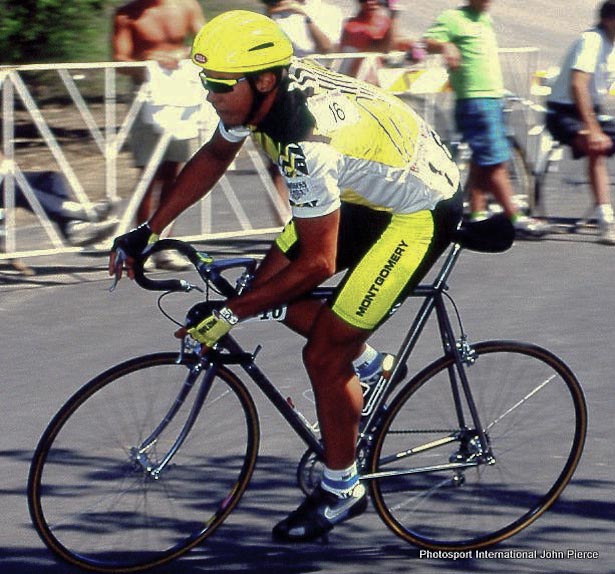
It was the following year in Maebashi in Japan when McCarthy’s youthful dreams of Worlds glory began to seem less farfetched when he mounted the podium of the World Amateur Pursuit Championship in third spot behind Russians Evgeni Berzin and Valerj Baturo.
“It was a surprise result but I had good form and I always seemed to go better on ‘neutral’ territory like Japan or Spain.
“I beat the German Jens Lehmann (1989 silver medallist and 1991 gold medallist) in the quarter final and then beat my countryman Steve Hegg in the ride off for bronze.
“I turned pro after the Worlds and rode the pro Worlds pursuit in Stuttgart in ’91 but went out by a very small margin in the quarter finals to Ekimov — the disappointment isn’t so intense when you’re beaten by a legend.”
It would be another year before McCarthy would realise his dream;
“In ’92 I decided I needed to get faster, I was 4th in ’89 in the TTT, third in ’90 and then 5th in ’91 so I figured that in ’92, I could win.
“From when I was a kid on my very first trip to the Olympic training centre in December 1983, when they asked what our goals were, I said, ‘to be a World Champion.’
“Everyone laughed, I was this fat kid from New York but winning the Worlds was what drove me.
“And I knew that but for that narrow defeat by Ekimov my dream was possible.”
Despite a successful US domestic season Subaru released McCarthy from his contract in October 1991;
“I hadn’t spoken to any other teams about a ride for 1992 so I trained with a vengeance.
“I worked in a bike shop and Fred Mengoni gave me a contract, it wasn’t great basic money but I got win bonuses — and on a run when the lowest I placed in a US race was second I was doing OK financially.
“But I needed to win the Worlds to prove that I wasn’t just a crit rider.
“I rode the Super Week crits in Milwaukee and then I went up to Colorado to live and train for six weeks to prepare for the Worlds.
“Because I was a professional, I couldn’t stay at the Olympic Training Centre, but I could train on the track. I lived in a basement and by the time I flew to Valencia for the championships, I’d lost 16 lbs.
“It was a pure experience, back to basics; I lived breathed and ate cycling.
“I’d wake at 07:00 and be on the rollers for 07:15 for 30 minutes; I’d be on the track for 08:45 and do three hours; I’d have lunch, take a nap then do 100 kilometres in the mountains.
“I’d alternate two days of that routine with a rest day, and then three days with a rest day — whilst I couldn’t stay at the Olympic Training Centre, Craig Griffin the national coach allowed me to train with the amateurs on the track.
“Everything lined up, there was confluence.”
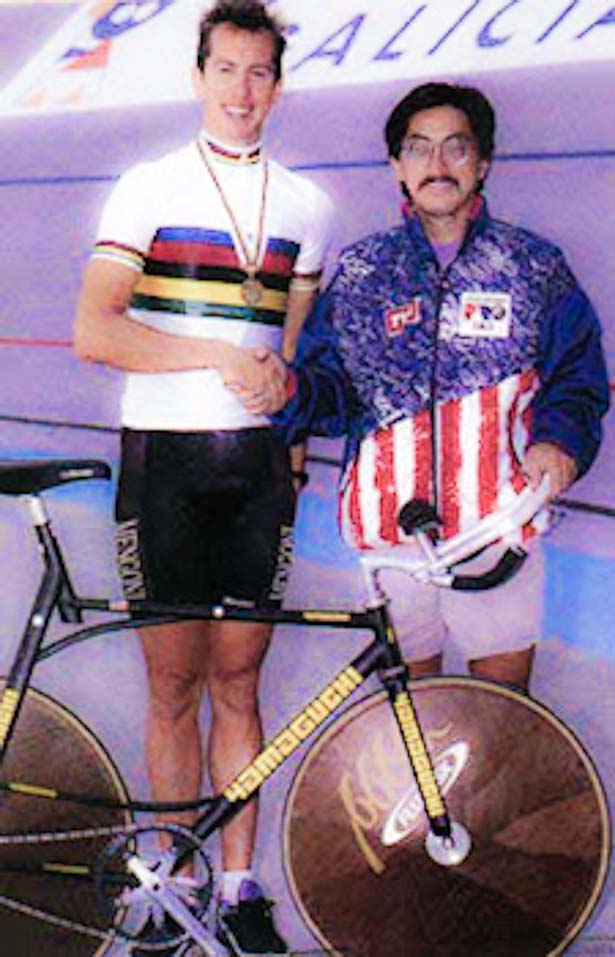
McCarthy left nothing to chance, enlisting the services of cult frame builder Koichi Yamaguchi who learned his craft in the mythical 3Rensho factory in Japan building keirin frames, including those for 10 time world sprint champion, Koichi Nakano.
“The way we figured it was if I couldn’t go fast then at least the bike should look fast!
“And we decided, ‘what the heck!’ let’s build something different — Koichi had this filing cabinet full of crazy bike designs and we sat down and went through that.
“At the time it set the bar pretty high for bike design — that machine is in the US Bicycling Hall of fame, now.
“In the final I beat the English rider, Shaun Wallace — he was riding Chris Boardman’s Lotus bike and during training on the track at Valencia we were kinda eyeing each other, we could both see that the other was going well.
“Shaun also trained for the ’92 Worlds in Colorado Springs and we had been team mates on Sunkyong, so the “eyeing each other” thing was started well ahead of the Worlds.
“My biggest fear was that I was going to get on my no-seat-tube Yamaguchi for the first time with Shaun watching and have the bike come totally apart.
“Luckily, it was a strong bike.”
But it was the man from the ‘wrong’ side of the Atlantic who prevailed in the final.
In those days a pursuit rainbow jersey guaranteed a good contract with a road team, but it didn’t quite work out that way;
“I had offers, Jan Raas was interested and so were some others.
“But I knew that at that time US riders on European teams usually had a tough time.
“I was talking to Mike Neel about a contract with a big budget US based team which he was putting together but the rug got pulled at the last minute.
“I don’t remember much about the details — except that we would have been riding Rossin bikes.”
Whilst there wasn’t a road team contract, there were plenty of offers for the winter boards.
Mike got contracts for every Six Day on the calendar and he ended up riding five of them, which he admits are a bit of an unpleasant memory;
“I rode with Tony Doyle, Dean Woods and Werner Stutz – the first one I rode was Dortmund.
“The best was Bordeaux which I rode with Stutz, he was a good guy to ride with and that was the first Six where I was allowed to win chases.
“Gent with Tony Doyle was a good experience, whilst there’s ‘organisation’ going on during a Six Day, you still have to be riding at 50 kph and be strong enough to earn your place in the hierarchy. Or back then you had the big road stars riding and they were treated with respect.
“It was a hard world to break in to — Tony and Woodsy had been through it, so they knew the score. Physically I was unprepared for 200 kilometres of racing for six nights in a row, week after week and by Zurich I was wasted.
“I’m not a quitter but I had to go home, I was eight months off the bike and lost the whole of 1993 with chronic fatigue syndrome.
“There I was with a rainbow jersey and I could hardly ride 10 kilometres.
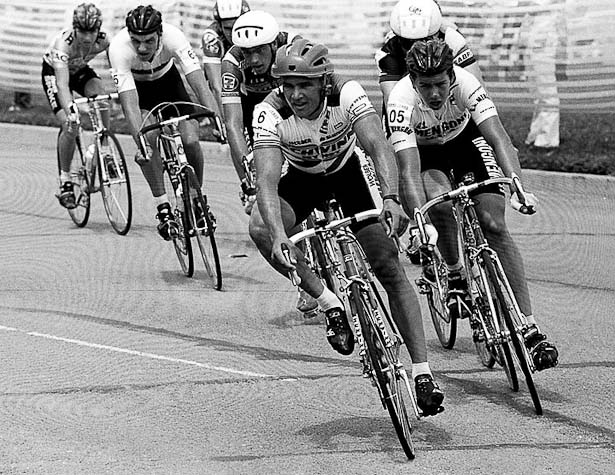
Mike didn’t race again until September 1993.
It would have been easy for McCarthy to walk away from the sport but he was back for ’94 and soon found new challenges.
“For ’94 I rode for the Breakaway Couriers team, they paid me to ride and said; ‘we don’t think you’re finished with cycling yet.’
“I went to the Worlds in Palermo in ’94 to watch; Marty Nothstein won the sprint and keirin which inspired the decision that I wanted to ride the ’96 Atlanta Olympics and the ’98 Goodwill Games, which were to be held in New York.
“I managed to get back on the 1996 Olympic programme; or ‘Project 96’ as it was known.
“It was tough to break in to with an emphasis on fast bikes and clothing with a bunch of young kids who didn’t really want me on board. I rode the team pursuit, but one of my biggest disappointments in the sport is that I didn’t get to ride the individual pursuit. The spot went to Kent Bostick who was a 40 year-old time trial rider.
“In the team pursuit we were 6th, the US team had won bronze in the Worlds at Bogota in ’95 but strange things happen at the Olympics. I would say that I was ‘good’ but not spectacular, that year.”
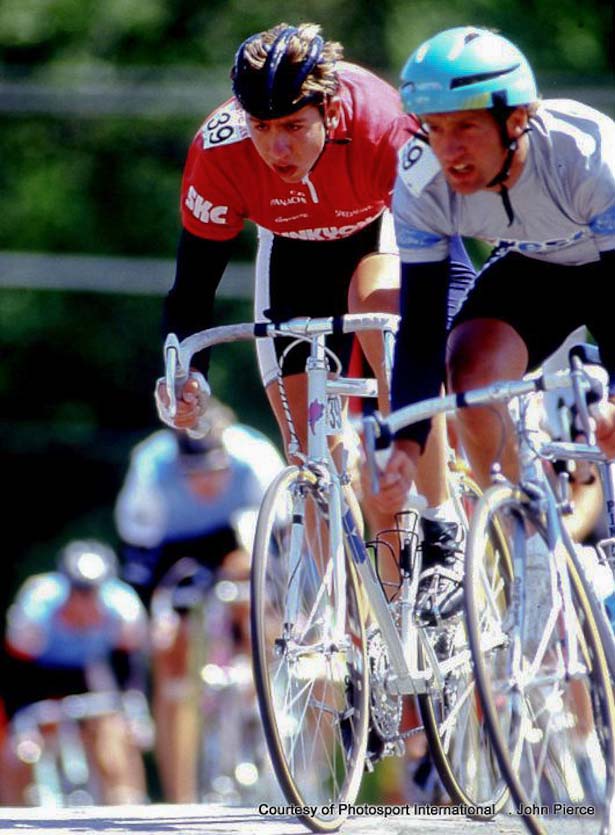
But McCarthy’s last big adventure on the international stage would be a much more positive experience.
“The Goodwill Games in New York City in ’98 were two of my best days ever on the bike.
[The Goodwill Games was an international sports competition, created by US media mogul Ted Turner in reaction to the political troubles surrounding the politically boycotted Olympic Games of the 1980s.]
“In the run up to the Games, because I was the ‘home boy’, they used my image in a lot of the advertising on buses and billboards — that was good for my morale and I trained hard for the races.
“The events were held over two days on a tiny 155 metre outdoor track; it was a kind of omnium format with everything massed start — scratch, elimination and points.
“I won four of the six races I rode and the US ran out winning team.
Despite still being competitive — with wins in the US, Japan and Bermuda — in 1998, McCarthy decided it was time to stop.
“An athlete has to make choices and my motto was always, ‘quit while you’re ahead’ — I never wanted to be told to quit.
“You have to ask yourself, ‘am I still going good?’ and ‘am I still having fun?’
“In ’97 we went to a race and it was cancelled due to flooding on the course — I was happy not to be racing. I knew the end was near when I had those feelings — you shouldn’t be happy not to race.
“I had to work hard to be good — I mean I never looked like a cool athlete, I looked like a mechanic. The transition to the real world wasn’t bad for me; I got an opportunity from Thom Weisel to go in to the financial business with Montgomery Securities and I’ve been in that industry ever since.”
And in interviews like this, one must always enquire about, ‘regrets.’
“I guess you can always pick through the ashes — I regret not giving Europe a shot.
“When I was a junior, Jim Ochowicz offered me a slot on one of his teams but I didn’t accept, I’d already given my word to Fred Mengoni that I’d ride for him.
“Jim said to me, ‘you’ll never, ever ride for one of my teams.’
And whilst Jim and I are friendly now, that ruled me out of ever riding for 7-Eleven.
“I’d have loved to have been involved with that Lance/Ochowicz European scene — it would have been good to have tried.
“But there are little things too — I regret not having won the Tour of Somerville in the States, for instance.
“And losing the ’96 Olympic pursuit slot to Kent Bostick — that’s definitely a regret.
“But I all in all, I had a pretty great run. And I think I got out at a good time, the sport was changing, and many of the guys weren’t fuelling on bread and water anymore, if you know what I mean? — but I know that I won in Valencia on carrots and peas!”
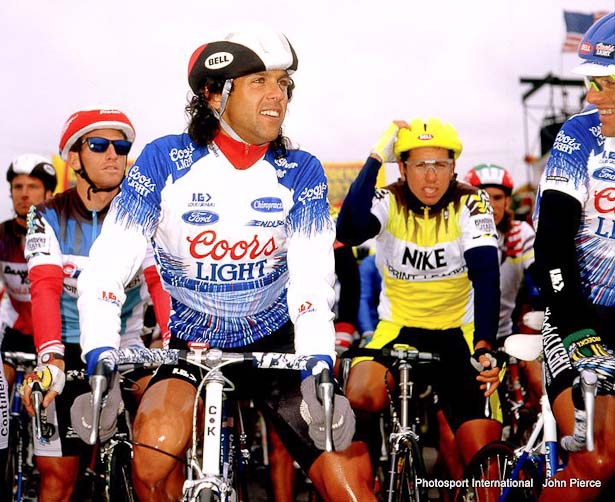
Thanks to John Pierce / Photosport International for the photographs.
